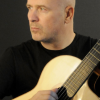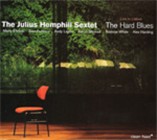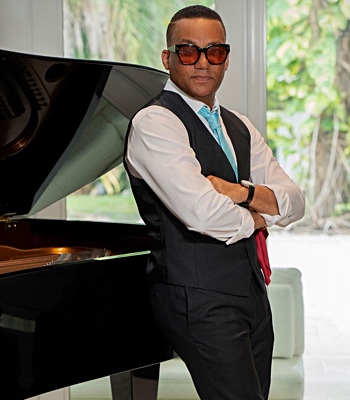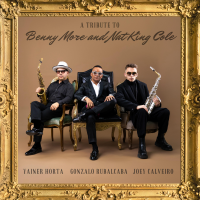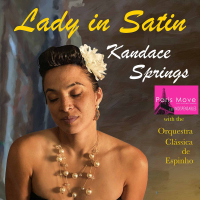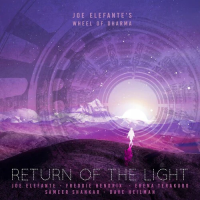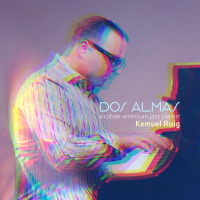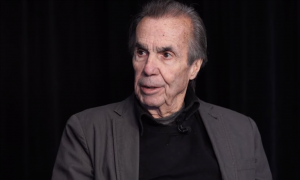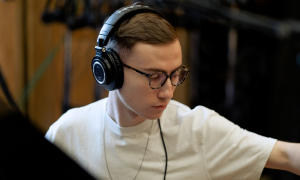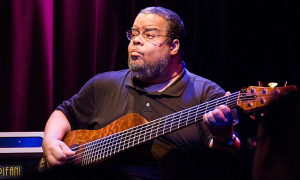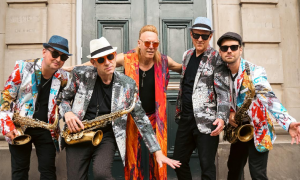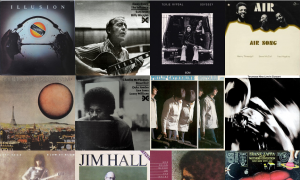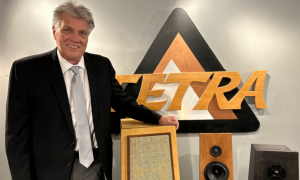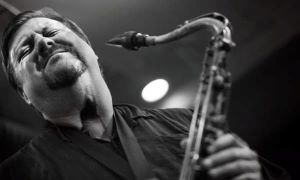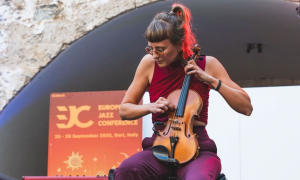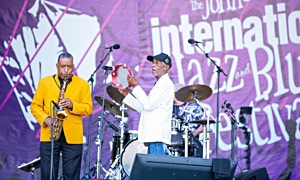Home » Jazz Articles » Interview » Simone Guiducci: Dancin' Roots
Simone Guiducci: Dancin' Roots
It's true that the Gramelot sound has been inspired by Italian popular music, but our approach is necessarily very different from the groups who play ethnic music.
Born in 1962 in Turin, Italy, guitarist and composer Simone Guiducci has been hailed as a creative voice on the contemporary Italian jazz scene. He's made several internationally acclaimed recordings as a leader including his two latest, Dancin' Roots (Felmay, 2005) and Chorale (Felmay, 2003). With his ongoing project "Gramelot", Guiducci explores the creative dialogue between Italian folklore themes and jazz improvisation.
His "Gramelot Ensemble" has been comprised of distinguished Italian musicians over the years including Enrico Rava, Paolo Fresu, Gianluigi Trovesi and other leading international artists including Ralph Alessi, Chris Speed, Erik Friedlander, Don Byron and Eberhard Weber.
This October 2004 interview was translated and reprinted courtesy of All About Jazz: Italy.
 All About Jazz: Gramelot Ensemble's new disc Dancin' Roots is imbued with a clearly contemporary flavor and involves some of the most illustrious contemporary names in its accustomed delving into Italian folklore. It seems to me therefore to be a logical development to Chorale.
All About Jazz: Gramelot Ensemble's new disc Dancin' Roots is imbued with a clearly contemporary flavor and involves some of the most illustrious contemporary names in its accustomed delving into Italian folklore. It seems to me therefore to be a logical development to Chorale.
Simone Guiducci: I'm glad that there is a sense that "Gramelot" is evolving as it follows its chosen path. I think that the group has managed to hang onto two fundamental characteristics: on the one hand its "sound", which owes its inspiration principally to the typical orchestrations of popular Italian music groups, and on the other, the principle of working with melodic-rhythmic material which, at least in the beginning, came from real North Italian folk music. However, with the passage of time, the "North-Italy" formula has slowly given way to opening up to external influences.
This is mainly due to the natural inclinations of the individual musicians in the group towards free improvisation, as they are by nature "irreverent" towards the strict definitions of folk.
Our contact with 'external' musicians like Ralph Alessi, Erik Friedlander and Chris Speed in recent years has been inspiring and fruitful and has led us gradually to enrich our basic recipe as well as introducing new ways of looking at material based on traditional music, which is after all, the basis of our work.
Ultimately, we have developed an approach which is less and less respectful of dyed-in-the-wool traditions, but much more stimulating for us.
I have to say that it is very difficult to meet folk musicians who are open to contamination from other musical genres (in the folk world, a musician who is innovative is often seen as a traitor and sinner!). The characteristics of musicians without frontiers who are curious to explore new modes and have no "geographical" prejudices form the identikit picture of a "free improviser with a jazz background" like Alessi, Friedlander, Speed and of course, Don Byron, who is our guest on Dancin' Roots.
Working with them has been a fantastic opportunity for us to grow.
 AAJ: Was it Ralph Alessi, who you had already worked with, who was responsible for involving Don Byron and Andy Milne in the project? How did you get on personally and musically with them?
AAJ: Was it Ralph Alessi, who you had already worked with, who was responsible for involving Don Byron and Andy Milne in the project? How did you get on personally and musically with them?
SG: Ralph Alessi's interest and respect for Gramelot have obviously been important factors in the development of the new project. We recorded two pieces on our previous record Chorale with him as a guest and we realized that there was an immediate empathy between him and the group. Of all the tracks we did on the old record, Chris Speed and Erik Friedlander too were on some of them, the ones we did with Ralph were those which inspired us most. The chemistry between our tones and his very personal trumpet sound and his lyrical but totally modern style added something special to Gramelot's palette. In fact, I didn't see Alessi as a guest artist, but as a real member of the group.
In 2002 and 2003, I put a lot of energy into organizing live tours with him and every time we played, I felt the fusion with Gramelot grow stronger and stronger. We all decided together to record a whole album with him as guest. Ralph's sustained respect and interest in becoming a regular member of the group was reinforced by his support for the idea of letting Don Byron hear our work.
AAJ: And he, in the light of developments, obviously liked your work.
SG: I have to confess I was surprised by the availability of Don Byron and Andy Milne (who later took part in the recording of one track) to the idea of working together. Everything that's happened made me realize that when you work with innovators, with artists who have no barriers to their artistic expression, it's not too difficult to have a level of spontaneous communication which goes far beyond recording contracts and stuff like that. I can remember very well, for example, when I had no thoughts about Don Byron playing on the track "Chorale no. 2" (where Andy Milne does a very intense solo), he himself went with his instincts and knew that he wanted to be a part of it instead of remaining silent as we had planned. This was a clear sign that the atmosphere in the recording studio, in the "Mingus" style, was enough to inspire him. There was an air of relaxed experimentation during the recording and, at least in my opinion, you can hear this from the results.
AAJ: In the cover notes for Dancin' Roots, you wrote "A free flow of ideas and cultures is our aim. It's also an advantage and a drawback". Can you explain what you meant?
SG: This is a wide subject which comes out of our awareness that we cannot play real "music from the roots". Our folklore is by necessity an "imaginary folklore" constructed from memories which bring to life again the melodies and rhythms which come from popular music but which use them as free inspiration for reworking and not as an interpretation of archaic musical forms handed down by word of mouth. I've thought a lot about these things too because Gramelot works under the Felmay label and for years this label has mainly produced ethnic and world music. Cantador, Chorale and our latest disc are in the NEW category of the label, while the major part of their catalogue is in the ROOTS category. In this section there are great folk artists who are maybe not that well-known like the Bulgarian clarinetist Yasko Argirov, the Indian tabla player Sankha Chatterjee, the Kazhakistan akku player Raushan Orazbaeva (the akku is a kind of violin), as well as other better known musicians like Tenores di Bitti.
It's true that the Gramelot sound has been inspired by Italian popular music, but our approach is necessarily very different from the groups who play ethnic music. In a way I envy the purity of expression of artists who can say they "know how to play their music because it's been handed down to them". But, I accept that I live in a western society made up of thousands of different races and traditions who have to communicate with each other. As I said in my notes to our record, in the day and age in which we live, it seems absurd to me to limit ourselves to celebrating our own ethnic background, although a profound awareness of our own roots can help us to feel stronger and more open to communicating with "other cultures".
 We just have to look at the traditions of jazz, or even flamenco or Indian raga to see some examples. Jazz is surely among the most "contaminated" of world music styles and has been right from its beginnings, but it is also the one which offers the greatest variety of styles thanks to its extraordinary evolution.
We just have to look at the traditions of jazz, or even flamenco or Indian raga to see some examples. Jazz is surely among the most "contaminated" of world music styles and has been right from its beginnings, but it is also the one which offers the greatest variety of styles thanks to its extraordinary evolution.
AAJ: Gramelot Ensemble celebrates its tenth anniversary with this album. This seems a remarkable achievement to me when so many groups stay together only for the time it takes to cut one album. How do you explain your long life?
SG: We were lucky enough to get together the right musicians ten years ago, when they were just beginning on their careers, great talents like clarinetist Achille Succi, accordionist Fausto Beccalossi, drummer Roberto Dani and bassist Salvatore Maiore. If I deserve any praise it is because I recognized a common interest in experimentation and a common curiosity about popular material and was constantly pushing for an original, non-conventional approach in the work of Gramelot. The fact that we have lasted is probably due to having created an atmosphere where everybody feels stimulated to contribute their own ideas. This has enabled us to survive even during periods when there was little on offer on the live music scene and to grow slowly as a group through continuous rehearsing together. I know this sounds a bit odd in Italy where many groups try out their repertoire during the sound-check before a concert! But all joking apart, I hope that the type of creative workshop that we have will continue for a long time yet, along with the growing commitments of the members of the group who are all in the forefront of the national jazz scene.
 AAJ: What guitarists (or musicians in general) have had the greatest influence on you?
AAJ: What guitarists (or musicians in general) have had the greatest influence on you?
SG: In a broad musical sense, I think I have been most influenced by the great 'explorers' like Miles Davis, Joe Zawinul, Egberto Gismonti and John Coltrane, but also by Joni Mitchell and Bill Frisell. Closer to home, Enrico Rava in the era of "String Band" was undoubtedly one of the most important influences on me. His concert in Mantua in 1984 with Tony Oxley, literally turned me upside down. As far as guitarists are concerned, I would say masters like Django Reinhardt and Jim Hall and at a second level "backing" musicians like Pat Metheny or Bill Frisell himself, who were important because they brought me closer to the masters. When I was a teenager, I was crazy about Jimi Hendrix, who was also a great innovator, but later I found a sound dimension closer to my perception of that of the acoustic guitar.
I think the first big bolt of lightning was when I was sixteen and listening only to people like Led Zeppelin, Genesis and Jimi Hendrix and I happened to hear Django's "Nuages", which at my level of knowledge of the guitar at that time was completely incomprehensible, but absolutely electrifying to my ear. I'm still trying to understand it today!!!
AAJ: Which album is most representative of you?
S.G: That's an easy question to answer. All three of the records Gramelot Ensemble has made for Felmay: Cantador in 2000, Chorale in 2002 and the most recent Dancin' Roots. However, I have to say that sooner or later I want to record a live Gramelot concert because I think we show our maturity at its best in concert.
 The recordings of our summer tour in 2003 with Ralph Alessi, which include some of the tracks from Dancin' Roots (not yet edited at that time) as well as all the best tracks from our previous records are the best examples of live Gramelot concerts.
The recordings of our summer tour in 2003 with Ralph Alessi, which include some of the tracks from Dancin' Roots (not yet edited at that time) as well as all the best tracks from our previous records are the best examples of live Gramelot concerts.
AAJ: What are your plans for the near future?
S.G: I'm becoming more and more convinced that "diversions" off the main road I'm following with Gramelot are not fruitful and are even damaging. So, I'm thinking of just going ahead with only a couple of projects as well as making some records. I have just been in Cologne in Germany where I took part in a recording to be issued by Nicolas Simion in a quintet which also included Zoltan Lantos on the violin and Krunoslav Levacic on drums. We'll probably tour a bit in Germany and Eastern Europe next year. I am becoming more and more convinced that performing thirty concerts a month with thirty different programs, which some of our musicians try to do while they are on the crest of the wave, is not meaningful in an artistic sense. Music for me is nothing other than a great pleasure and a source of stimulus; I can no longer look at it as only a job. Last year, I too went on tour like a spinning top with trains, planes and hours in traffic jams on the motorway. Now, as well as responding to invitations to present Gramelot (which come quite often fortunately), I can stay at home and study or turn my guitar towards the hills and sing, or go out to eat a big plate of "capunsei" with my wife and son. My part-time work as a guitar teacher means that I can choose.
However, in more concrete terms, I have in mind to do, sooner or later, some work with Gramelot which will again involve Erik Friedlander, another extraordinary musician who tests the limits and who left me feeling exhilarated and inspired after a few days working together. My main aim as a musician is, as always, to learn from those who inspire me. This is something worth putting all my energies into.
Visit Simone Guiducci on the web.
Article translated by Isabella Celentano.
Tags
PREVIOUS / NEXT
Support All About Jazz
 All About Jazz has been a pillar of jazz since 1995, championing it as an art form and, more importantly, supporting the musicians who make it. Our enduring commitment has made "AAJ" one of the most culturally important websites of its kind, read by hundreds of thousands of fans, musicians and industry figures every month.
All About Jazz has been a pillar of jazz since 1995, championing it as an art form and, more importantly, supporting the musicians who make it. Our enduring commitment has made "AAJ" one of the most culturally important websites of its kind, read by hundreds of thousands of fans, musicians and industry figures every month.


